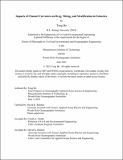Impacts of Channel Curvature on Drag, Mixing, and Stratification in Estuaries
Author(s)
Bo, Tong
DownloadThesis PDF (86.05Mb)
Advisor
Ralston, David K.
Terms of use
Metadata
Show full item recordAbstract
Estuaries often have sinuous planforms, and channel curvature can lead to distinct flow processes in bends, e.g., secondary circulation and flow separation. An integrated approach combining field observations, idealized modeling, and realistic modeling is used to understand how curvature-induced flow processes affect hydrodynamic drag, salinity mixing, and stratification in estuaries. In the North River (MA, USA), a sinuous, tidally-dominated estuary, drag is observed to be much greater than typically found in straight channel estuaries, and data analysis points to links between the high drag and curvature-induced processes. Idealized models and a realistic North River model are developed to investigate the mechanisms of drag increase in sinuous estuaries. Two key processes are found to dominate. First, flow separation leads to low-pressure eddies on the lee side of bends and thus creates bend-scale form drag. Second, curvature-induced secondary circulation transports higher momentum fluid from the surface toward the bed. Consequently, the near-bed shear and bottom stress are enhanced compared with a logarithmic velocity profile. The form drag due to flow separation and enhanced bed stress due to secondary circulation combine to increase the drag in the North River by a factor of 2-5 compared to the expected values. In addition to increasing the drag, channel curvature also affects the salinity distribution, mixing, and stratification. During ebb tides, secondary circulation in bends interacts with the salinity field to create bottom salinity fronts upstream of bend apexes. Intense mixing occurs at these curvature-induced fronts and leads to overall decreased stratification in sinuous estuaries compared to straight channels. In addition, flow separation in bends and at channel constrictions can create sharp lateral salinity gradients through differential advection during flood tides, and the resulting baroclinic forcing influences secondary circulation. Surface convergence fronts are generated at bends and constrictions as secondary circulation interacts with the laterally sheared flow, resulting in intensified mixing near the fronts. This thesis advances our understanding of how flow curvature affects the hydrodynamics, salinity, and mixing in estuaries with complex topographic features found in natural systems.
Date issued
2023-06Department
Massachusetts Institute of Technology. Department of Civil and Environmental EngineeringPublisher
Massachusetts Institute of Technology